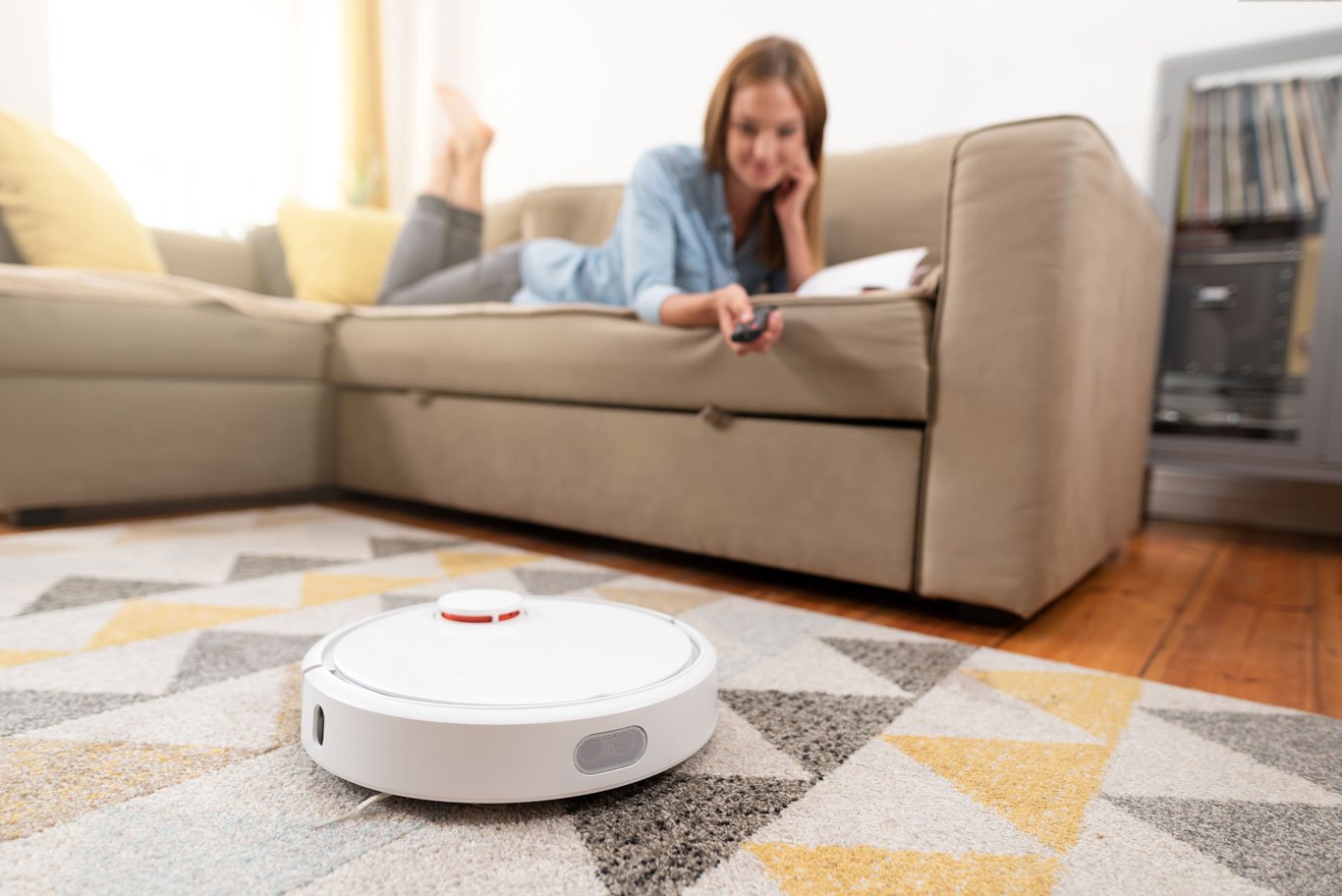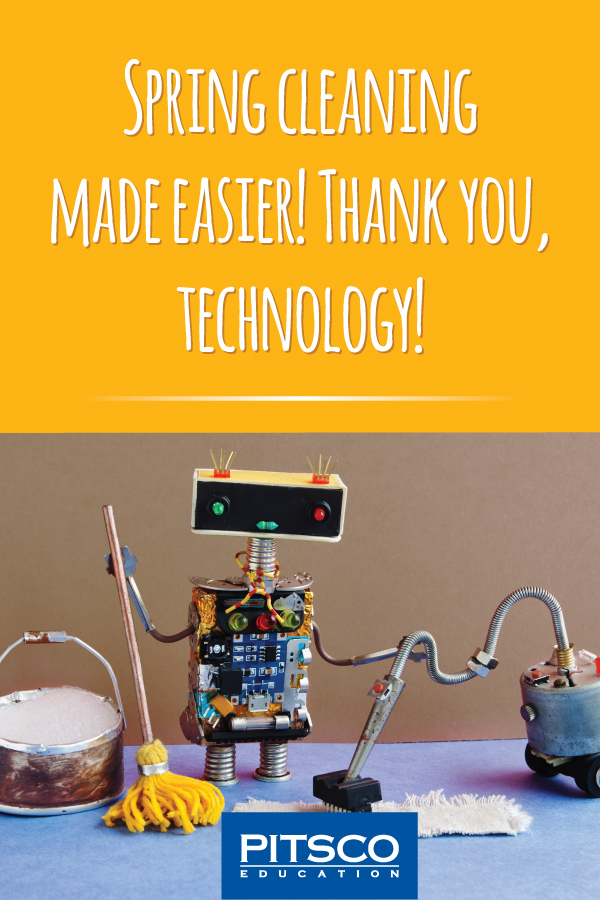Spring is almost here! With it comes rain, warmer weather, and that itch to soak up the sun that seems to have hidden from us for so long. If you’re anything like me, the to-do list of spring cleaning has gotten long and, with the glimpses of sunshine, I just don’t want to do any of it. Thank goodness technology can make getting through that chore list a little easier and much quicker! So, here’s a look at some of the technology behind products we use in our daily lives and ways to help bring that tech into your students’ lives!
The Future of Cleaning Is Here
A simple example of this technology is the automatic dispenser, be it soap, paper towels, or even hot air. When you wave your hand in front of the sensor of an automatic dispenser, there are a couple different ways it can sense you’re there.
- Infrared sensor – This sensor works by measuring the heat your body gives off. It emits infrared radiation and reads the energy that is returned. When you put your hands near the sensor, your body gives off energy that then triggers the sensor to dispense the product.
- Photo sensor/light sensor – The more popular type of sensor is the photo sensor. A light beam is used to activate the dispenser. When your hands are placed under or in front of the light, the machine will then perform its function (“An Insight on How the Best Automatic Soap Dispensers Work”).
Another piece of equipment you might use that incorporates a ton of different sensors? A Roomba®! While not the first automatic robot vacuum, Roomba was the first widely successful version. Cleaning is something we all have to do, but why not hand it over to robots to help out! The Roomba, as well as most robotic vacuums, is a vacuum that can be programmed to work at any time of the day, navigating around different objects to sweep (or even mop) your entire floor.
 Robotic vacuums use a couple different sensors in order to operate, including photocell sensors, touch sensors, and infrared sensors mounted to the bottom. The photocell and infrared sensors do a couple different things, such as detect walls and obstacles and slow down the vacuum so it doesn’t hit them at full speed. The touch sensor tells the vacuum that it’s pressed up against an obstacle and triggers the turn so that it can keep cleaning. The bottom-mounted infrared sensors can detect drop-offs, such as stairs or a ledge, so it doesn’t accidentally drive itself off the edge of a surface (“Roomba Robot Vacuum Cleaners”).
Robotic vacuums use a couple different sensors in order to operate, including photocell sensors, touch sensors, and infrared sensors mounted to the bottom. The photocell and infrared sensors do a couple different things, such as detect walls and obstacles and slow down the vacuum so it doesn’t hit them at full speed. The touch sensor tells the vacuum that it’s pressed up against an obstacle and triggers the turn so that it can keep cleaning. The bottom-mounted infrared sensors can detect drop-offs, such as stairs or a ledge, so it doesn’t accidentally drive itself off the edge of a surface (“Roomba Robot Vacuum Cleaners”).
Sensing Some DIY Ideas
Using the Microduino MIX Kits, I was able to put some of these sensors into play. I was able to put the line finder sensor to work in two different builds. The line finder is a bit of a misnomer, as you can use it to do so much more than just find lines! It senses differences in light, so you can use it to find edges, find lines, or sense motion by sensing a difference in light capacity.
In the first build, I loosely re-created the touch sensor on the Roomba by telling the line finder to change direction of the motors only when it sensed a significant change in light, such as when the robot is pressed up against a wall. In the second build, I used those same line finders to sense the edge of a table and change direction based on that edge. By looping my code, I never had to worry about my bot falling off the edge of the table as it always looked for a sudden change in light intensity.
However, there are other ways to practice putting these sensors into play. TETRIX® has a full array of sensors and inputs. If you want to practice not running a robot into a wall, the ultrasonic sensor can sense distances from three centimeters to up to 400 centimeters and can be used to identify all sorts of obstacles that might be in the way. You could also help prevent the spread of germs by using either the TETRIX MAX or TETRIX PRIME Gripper Kit to grab, pick up, and move objects. Build a robot such as the TETRIX PRIME Snappee Bot to help get a grip on your spring cleaning.
What other ways has technology impacted or improved cleaning processes? Have students brainstorm! There are a lot of different ways to introduce the sensors we use in our daily lives in new, interesting ways. Have ideas for how to use robotics and sensors into your classroom or home? Let us know!
Resources:
“An Insight on How the Best Automatic Soap Dispensers Work”
“Roomba Robot Vacuum Cleaners”



 Robotic vacuums use a couple different sensors in order to operate, including photocell sensors, touch sensors, and infrared sensors mounted to the bottom. The photocell and infrared sensors do a couple different things, such as detect walls and obstacles and slow down the vacuum so it doesn’t hit them at full speed. The touch sensor tells the vacuum that it’s pressed up against an obstacle and triggers the turn so that it can keep cleaning. The bottom-mounted infrared sensors can detect drop-offs, such as stairs or a ledge, so it doesn’t accidentally drive itself off the edge of a surface (“
Robotic vacuums use a couple different sensors in order to operate, including photocell sensors, touch sensors, and infrared sensors mounted to the bottom. The photocell and infrared sensors do a couple different things, such as detect walls and obstacles and slow down the vacuum so it doesn’t hit them at full speed. The touch sensor tells the vacuum that it’s pressed up against an obstacle and triggers the turn so that it can keep cleaning. The bottom-mounted infrared sensors can detect drop-offs, such as stairs or a ledge, so it doesn’t accidentally drive itself off the edge of a surface (“

